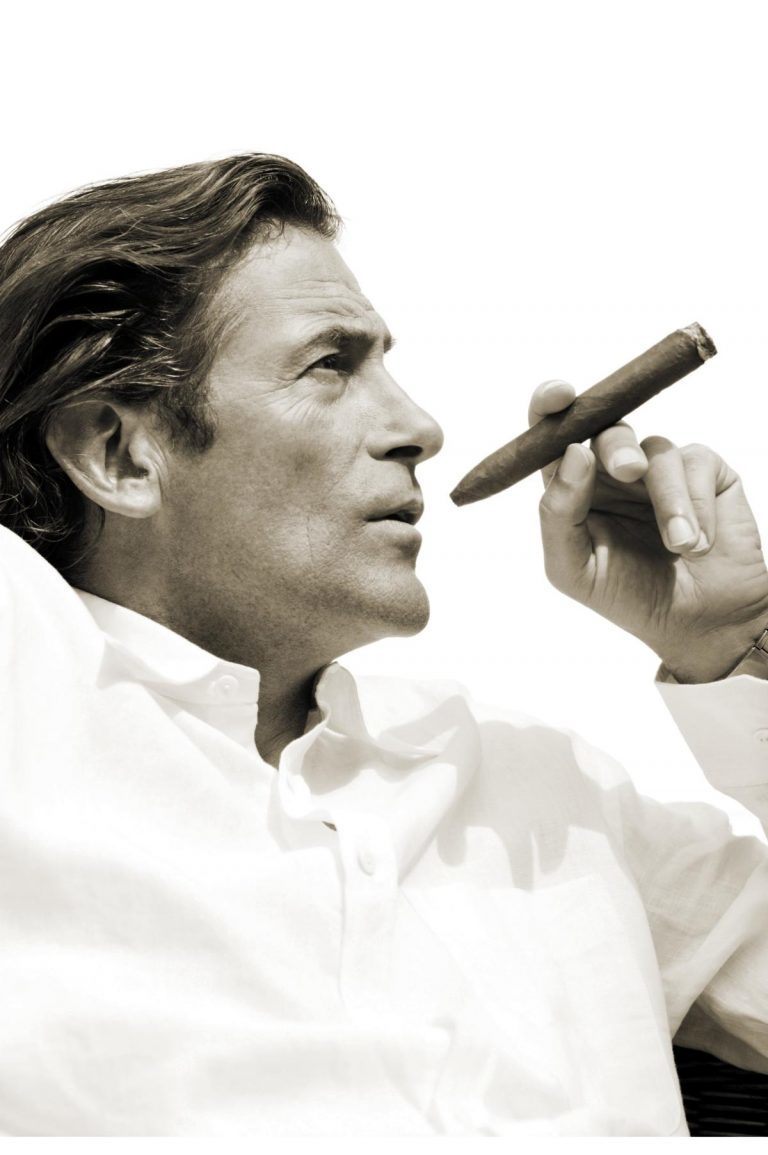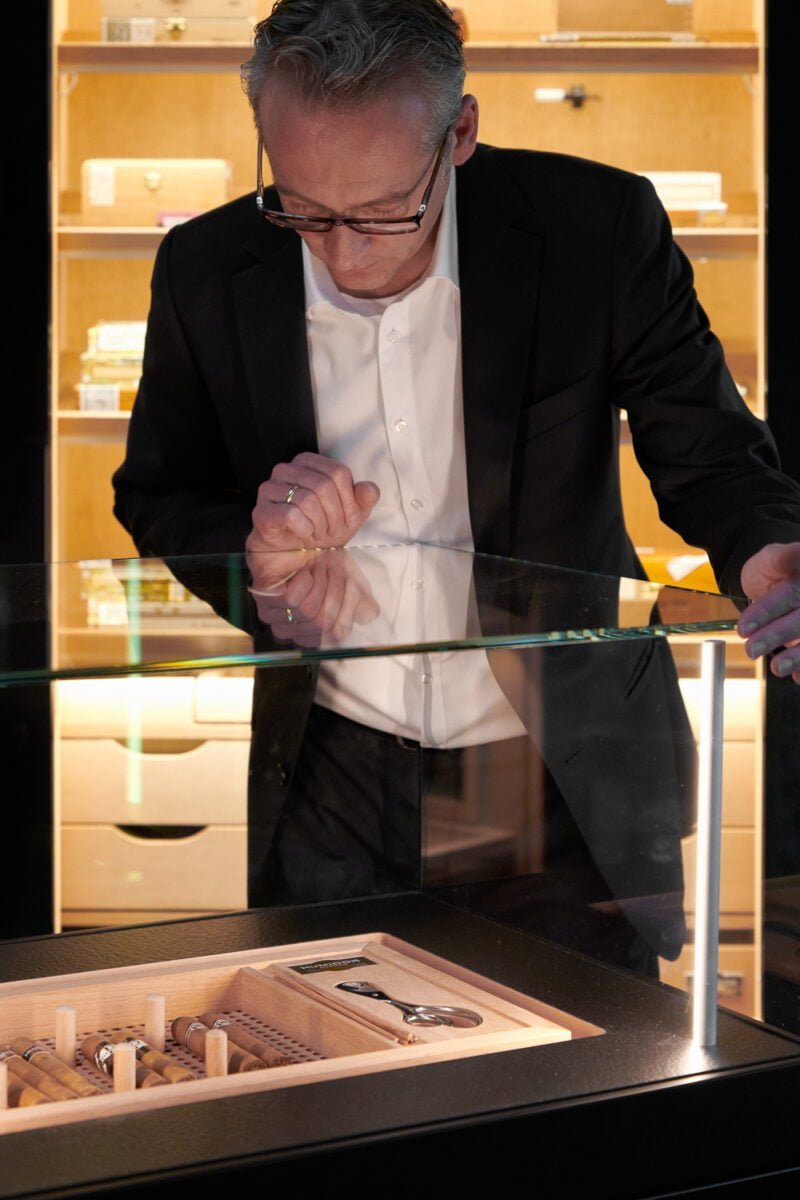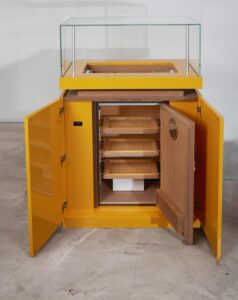

Smoke rises while enjoying a cigar from a Gerber humidor
And the scent of a fine cigar fills the room – like a good idea
Despite several obvious differences in personality, people like Thomas Mann, Sigmund Freud, and Winston Churchill all shared a common passion: each one of them appreciated a good cigar and celebrated the enjoyment of smoking. For them, only the best would do. And the best requires a lot of time, love, and care. Only in this way can a cigar, like a fine wine, mature to its highest level. We develop humidors to these exacting requirements.
Gerber humidors have always been manufactured by hand in our own factory. With great care and attention to detail, a humidor is created that is tailored to the individual needs of the customer. The valuable cigar treasure can be stored over a long period of time without drying out. The versatile interior can be optimally adapted to the cigar collection and separates the different varieties and aromas. Special amenities, such as the handmade service board, make preparing and smoking the cigar an incomparable pleasure.
Gerber Humidors
have always been manufactured by hand in our own factory. With great care and attention to detail, a humidor is created that is tailored to the individual needs of the customer. The valuable cigar treasure can be stored over a long period of time without drying out. The versatile interior can be optimally adapted to the cigar collection and separates the different varieties and aromas. Special amenities, such as the handmade service board, make preparing and smoking the cigar an incomparable pleasure


Quality
The history of the cigar
A cigar was and is always something special. It stands for a special moment of tranquillity, of contemplation, of leisure and enjoyment or for a celebration and a victory. Just think of famous cigar smokers like Rudi Assauer, for whom every victory of the Schalker squires was won with a cigar and every unsuccessful game with a good cigar tasted less bitter. The smoking of a cigar is celebrated, including, as in a traditional tea ceremony, the personal ritual, the appreciative handling and also the right technique from storage to smoking behavior to enjoy the cigar properly. From time immemorial, the cigar was never intended for everyday use; even at the beginning of the discovery of tobacco and the origins of the cigar, it was reserved for the gods and tribal chiefs in South America.
The beginnings
Even if the exact beginnings of the cigar have not been clarified too clearly to this day, there is agreement that the use of tobacco and thus the development of the cigar most probably originated somewhere on the South American continent. Tobacco is extracted from the leaves of certain species of the genus Nicotiana. Today’s botanical genus name Nicotiana goes back to its namesake Jean Nicot, who introduced tobacco as a medicinal plant in France in the 16th century. Since most Nicotiana species are native to South America and still find the best growing conditions there today, one can assume that the possibility of using the tobacco leaf has also been discovered there. It can only be speculated whether the usability of tobacco is a coincidence or whether the South American Indians in search of medicinal and useful plants have noticed the leaves of the plants and their properties. Legend has it that the dried leaves were used thousands of years ago to honour the gods with the rising smoke and the unfolding smells and to make them positive. It is easy to imagine that even then the leaves were twisted in the shape of a cigar to allow better burning. The smoke of the first cigars was probably reserved for chieftains and priests. Only they were able to get in touch with supernatural powers with the help of cigar smoke. Even then, the aromatic times of smoking stood for the special and the unique moment.
The word cigar
The origin of the word „cigar“ most probably comes from the language of the ancient Mayas. The Mayas called a cigar a „Ciq-Sigan“, from which the Spanish word for „cigarro“ was derived. Another version of the name’s history tells that the word cigar has its origin in the Spanish word cigale (cigaral), which alludes to the shape of an insect. The „New English Dictionary“ of 1735 calls a cigar a „Seegar“, which later became the modern word cigar. Cigars have only been written in Germany since the spelling reform of 1902.
The triumph of tobacco
Before Christopher Columbus reached the coasts of „India“, the tobacco plant was unknown in Europe. Although Greeks, Romans and Teutons had already snuffed or smoked herbs, and even there the smoke was often part of religious rituals, only the Indian cultures of South America knew of the fragrant tobacco. The probably first products and also the first plants brought Columbus and his seafarers back from the new world. There is a logbook entry of Christopher Columbus, dated 28.10.1492, in which he reports that the natives of San Salvador light and inhale the rolled leaves of a native plant. Rodigo de Xeres, a lieutenant of the expedition, was historically fascinated by the smoke of tobacco and then smoked the forerunner of the cigar each day of his journey. At that time, these often consisted of a corn, palm or similar plant leaf, into which finely chopped and dried tobacco was rolled. However, his passion became de Xeres‘ doom in Europe and he soon felt that smoking was frowned upon by the Indians. He spent ten years in the dungeons of the Inquisition because smoking tobacco was considered a pagan ritual. Nevertheless, the triumph of tobacco could not be stopped. The plant with the biological name Nicotiana Tabakum made its way into Europe from the 15th century onwards. When tobacco came to Spain in 1496 through the Spanish monk Peter Romanus Pane, a companion of Columbus, the plant first spread as an ornamental and medicinal plant in Spain and Portugal. Pane also reported that the natives took rolled leaves of a plant into their mouths, lit them and produced smoke to protect them against the mosquitoes. The word ‚tobacco‘ is said to have been derived from the Antillan word ‚tobacco‘ for a pipe used for smoking and to have been transferred to the dried tobacco leaves.
Tobacco in Europe
Around 1560, the envoy Jean Nicot brought the tobacco plant from the port city of Lisbon to the French court, where the tobacco plant quickly gained popularity as a medical panacea for many ailments and diseases.
Around 1600 tobacco was regarded as one of the most effective remedies and, in addition to smoking, was also used in numerous ointments, solutions and tinctures etc. as a medicine. The observed effects on the mind and psyche, such as increased concentration, activation of the vital forces and refreshment of the senses, were also appreciated.
After Europe had come to the good taste of the cigar, it also conquered the North American continent about two hundred years later. British colonial masters ensured that the population was supplied with imported cigars and extensive tobacco plantations were established on the territory of today’s USA. From the 19th century onwards, hardly any European could resist the smell of a smouldering cigar. During this period the consumption of cigars grew enormously – it was the flowering of the cigar in Europe. The production of cigars developed into an important economic sector in the age of industrialisation. It was the growing popularity of cigarettes that reduced the demand for cigars. The cigar was for some years reserved for their true lovers and aficionados. For about twenty years, however, more and more connoisseurs around the world have been igniting the hand-rolled tobacco leaves. The special smoke pleasure is a small luxury, which is celebrated in the private or in dignified clubs. The right lighting and smoking of a cigar is a skill, the right storage in the right humidor a science in itself.
History and Myth of Cuban Cigars
Cuba is the cradle of cigars and even today a Cuban cigar is living myth in the world of collectors and lovers. The hand-rolled works of art are considered by many aficionados to be the best in the world. On the Caribbean island, they are still today identity-forming and an important part of the lifestyle and culture. The varied history of the country is closely linked to the history of the Cuban cigar. It speaks for the quality and also for the peculiarity of a genuine „Habano“ that it has survived all the historical and political upheavals and still occupies an important place among the most remarkable cigars in the world.
Christopher Columbus and the Conquistadors reported that Native Americans smoked rolled tobacco wrappers. Many sailors were fascinated and made the customs their own. The opening and establishment of the sea routes paved the way for the triumphal march of Cuban cigars all over the world.
Tobacco plantations
The first tobacco plantations were established around 1620 in today’s USA, but in the colonies tobacco was only smoked in pipes. From around 1715 cigars were made from Cuban tobacco in Spain, the first cigar factory in Havana, the „Casa de Beneficiencia“, opened its workshops in 1799, around 1810 the first cigar brand in Cuba was invented. When the Spanish monopoly fell on tobacco in 1817, there was a huge boom in cigars in Cuba: in 1840 there were an estimated 300 manufacturers, later even more than 500.
(Another remarkable year: 1883 Gerber GmbH was founded by Carl Gerber in Duisburg – and perhaps also the first humidor was built in the Duisburg workshops).
The demand for higher quality cigars also increased in Europe and the Habanos soon dominated the market. The enjoyment of cigars became a popular custom in England and France, where smoking lounges and clubs with smoking rooms soon appeared in many places. The so-called house jacket, which was supposed to protect clothing from the smoke, is still called tuxedo today, meaningfully translated as „smoking suit“.
At the peak of Cuban cigar production there were about 1200 manufactories that exported more than 356 million cigars in 1855. After the USA increased customs duties and other measures, the industry in Cuba plunged into a crisis and at the beginning of the 20th century there were still about 120 cigar factories on the island. British and American investors bought more than half of the Cuban brand names, the world economic crisis led to a further reduction in the number of manufacturers and only a few manufactories remained independent.
Romeo y Julieta
In 1903 the eccentric billionaire „Pepin“ Fernandez Rodriguez bought the brand „Romeo y Julieta“ founded in 1850. Thanks to an advertising campaign that had never before been so intense, the brand quickly conquered the international market. „Pepin“ offered his cigars mainly on the racecourses of the world, where his mare „Julieta“ took action. The „Romeo y Julieta“ is still one of the best-known Havana brands in the world today.
In the years before the world economic crisis, the first belly bands for cigars were introduced and the distinction between varieties and formats was standardized. The world-famous tradition of reading aloud while rolling cigars also began during this period. It was created by a campaign of the weekly magazine for the tobacco industry „La Aurora“, which highlighted the advantages of public reading. The cigar rollers, also known as torcedores, are entertained at work by novels read aloud or by information about current events. Legend has it that the „Romeo y Julieta“ and „Montecristo“ brands were named after their famous literary counterparts. Shakespeare’s love story and the „Count of Monte Christo“ by Alexandre Dumas were among the favourite stories of the workers and inspired cigar producers to look for their names. The workers in the cigar factories are sometimes called „intellectuals of the proletariat“ because of their „reading“. Until today „lectora de tabaquería“ is a recognized profession in Cuba and was classified as a national cultural heritage in 2012. The more than 100 readers are not only an important part of the cigar rollers‘ daily work, they also contribute to the success of a good cigar.
Making a cigar
The creation of a noble cigar is still genuine craftsmanship, similar to the construction of a humidor a mixture of traditional work steps combined with current knowledge about material and technology. The precious raw material from which cigars are rolled by hand are the dried leaves of the tobacco plant.
Tobacco, or botanically Nicotiana tabacum, belongs like potatoes and tomatoes to the nightshade family. Tobacco plants are annual herbs that can reach a height of 2m. It is a subtropical plant with a corresponding need for warmth and an aversion to cold and night frosts. Nevertheless, the otherwise adaptable plant is planted in many different countries around the globe. Among the most important tobacco growing areas are Europe, North, Central and South America as well as the People’s Republic of China. The cultivation of tobacco for cigars is similar in most areas.
For Cuban cigars, only one particular type of tobacco is used, the so-called tobacco negro cubano. This name in turn includes different varieties, further developments of the plants originally found on the island. In Cuban experimental laboratories, the development and improvement of tobacco plants was carried out under strictly secret conditions. Above all, these plants should become more resistant to diseases, fungi and pests, since such an infestation has already endangered entire harvests in the past. What has been preserved is the unique, classic and unmistakable taste of Cuban black tobacco.
The perfect coat for a cigar
The tobacco leaves, which are later used as wrappers of a tasty cigar, are cultivated and cared for in an extraordinary way even during cultivation. At the beginning of the growth of the tobacco plants, the fields are covered with fabric sheets to protect the delicate plants from direct sunlight and weather damage. Like hops in this country, the plants are individually attached to wires. With proper irrigation, even and thin tobacco leaves develop, ideal as wrappers for unique enjoyment. The lower leaves of the plant produce rather light leaves, the closer the leaf grows to sunlight, the darker the result and the wrapper afterwards. This laborious cultivation method is called Tabaco tapado and guarantees the ideal conditions for the best bracts.
The tasteful interior
For the well-protected inner life of a cigar, the tobacco plants are cultivated according to the Tabaco de Sol method directly under the warming sunlight. The intensity of the sun allows the tobacco leaves to ripen and is responsible for the spiciness and flavour of the cigar’s treasures. Here, too, a different growing position on the tobacco plant produces a unique aroma. Each leaf is named and sorted according to its characteristics, similar to the cuvée in wine, the right blend of exceptional aromas produces the perfect result.
The taste of cigar tobacco is influenced not only by the sun, but also by the quality and cultivation of the soil. The tobacco is grown on evenly loosened soil and is transferred several times during growth. The so-called vegueros cultivate the plants by hand until they are perfectly ripe for harvesting. Each leaf is harvested individually according to its degree of ripeness. The entire plant is not harvested in a single picking process, but is gradually freed from its precious leaves. The harvested leaves are dried in the air in special drying sheds hung on long wooden poles. Already during the drying phase, the precious cigar raw material needs an even humidity like later during storage in the cigar cabinet. During this process, the leaves are checked again and again and are re-hung according to the drying process in order to create the most perfect conditions possible and to create the basis for unique enjoyment. After drying, the leaves are sorted and prepared for fermentation.
During fermentation in special premises, chemical and biological processes are used to remove unwanted substances and promote aroma formation. The stacks of tobacco, known as burros, must be constantly monitored, as their temperature must not exceed or fall below certain limits. The individual leaf varieties require different amounts of time to mature. Depending on the tobacco leaf, there are two or even three phases of fermentation. After the first phase, the leaves are sprayed evenly with water to control discoloration. Before the second fermentation, the leaves for the binder and insert of fine cigars are sprayed with water in order to develop the best taste.
The cigar needs the humidor
The rolled tobacco leaves that make up a cigar naturally dry out over time. They assume the maximum humidity of the environment. When an aficionado burns a cigar that has been stored in a normal room climate, he usually describes it as too dry. The reaction to fire is often poor and the enjoyment of the taste is limited.
For this reason, people began early on to store the precious cigars in places with higher humidity. Wine cellars or other underground rooms with a higher relative humidity by nature were often used for this purpose. Ultimately, it is always a question of imitating the tropical climate from which the tobacco originates. The higher humidity is a characteristic of all tobacco growing areas. But also the average temperature is naturally higher than in the Central European latitudes.
The first cigar boxes, which were manufactured decades ago in our carpentry workshop, were mainly used for decoration and safe transport. Particularly precious cigars were still individually packed in protective sleeves, but the best storage environment in terms of correct humidity was left to each collector. Many cigar lovers were interested in being able to smoke the cigars with full enjoyment over a longer period of time. An improvement of the storage possibility was therefore a goal of many collectors. The easiest way to achieve this was to further develop the classic cigar box into a container with changed humidity.
The idea of the humidor was born.
The idea was basically simple: the cigar boxes should have a higher humidity inside than the surrounding room. For this two things were necessary: on the one hand a material/container which can store and release humidity and if necessary a measuring instrument, in order to receive at least one idea of the prevailing values.
The first hygrometers were developed at the end of the 18th century. The so-called hair hygrometers were the first reproducible, physical measuring instruments for measuring air humidity. They made use of the property of human hair, which expands with humidity. Since blonde women’s hair is particularly fine, it was exactly these that were used in the first hygrometers.
The first humidifiers consisted of (nature) sponges, which were simply enclosed, manually humidified.
Also still today, sponge-based humidifiers are used in some humidors. These are favorable in the acquisition and can be accommodated without technical expenditure or further requirements in the humidor. The disadvantages lie above all in the uncontrollable delivery of the humidity to the ambient air. In addition, there is often an increased accumulation of bacteria and germs. Even though distilled water is now generally used for humidification, this reduces the bacterial load, but the sponge still provides a good breeding ground for spores and germs.
It is not known who first used the wood of the Spanish Cedar (Cedrela Odorata) for humidor construction. Since this wood comes from the tropics, it is only probable that it has started its triumphal march around the world together with tobacco. What the Spanish cedar has to offer in particular is described in a separate chapter: „The real humidor wood“.
In addition to the first humidifiers, the wood of the Spanish Cedar has had a positive influence on the regulation of humidity in the humidors. The raw, unprocessed wood functions in the humidor like a kind of moisture buffer. It can absorb damp air well and is durable at the same time. It shows good resistance to germs and is not very tasty for the tobacco beetle either.

